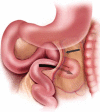Left paraduodenal hernia: case report and review of the literature
- PMID: 22797200
- PMCID: PMC3028131
- DOI: 10.1136/bcr.04.2010.2936
Left paraduodenal hernia: case report and review of the literature
Abstract
Paraduodenal hernias are congenital internal hernias that usually present with non-specific symptoms, and are therefore rarely diagnosed preoperatively. Left-sided paraduodenal hernias are three times more likely to occur than right-sided ones. Both hernias present similarly, but have a differing embryological basis. Here, the case of a 76-year-old woman with a left paraduodenal hernia presenting with small bowel obstruction is presented, and a brief discussion of the literature on its diagnosis and management given.
Conflict of interest statement
Figures




References
-
- Selçuk D, Kantarci F, Ogüt G, et al. Radiological evaluation of internal abdominal hernias. Turk J Gastroenterol 2005;16:57–64 - PubMed
-
- Khan MA, Lo AY, Vande Maele DM. Paraduodenal hernia. Am Surg 1998;64:1218–22 - PubMed
-
- Willwerth BM, Zollinger RM, Jr, Izant RJ., Jr Congenital mesocolic (paraduodenal) hernia. Embryologic basis of repair. Am J Surg 1974;128:358–61 - PubMed
-
- Blachar A, Federle MP. Internal hernia: an increasingly common cause of small bowel obstruction. Semin Ultrasound CT MR 2002;23:174–83 - PubMed
-
- Blachar A, Federle MP, Dodson SF. Internal hernia: clinical and imaging findings in 17 patients with emphasis on CT criteria. Radiology 2001;218:68–74 - PubMed
Publication types
MeSH terms
LinkOut - more resources
Full Text Sources
Medical
